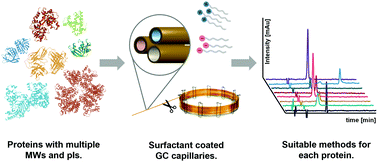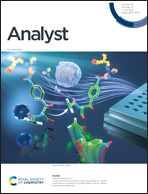Separation of intact proteins by capillary electrophoresis†
Abstract
This work introduces novel and universal workflows for the analysis of intact proteins by capillary electrophoresis and presents guidelines for the targeted selection of appropriate background electrolytes (BGEs) by consideration of the target proteins’ isoelectric point (pI). The suitability of neutral dimethyl polysiloxane (PDMS) capillaries with dynamic coatings of cationic cetyltrimethylammonium bromide (CTAB) or anionic sodium dodecyl sulfate (SDS), and bare fused silica (BFS) capillaries were systematically evaluated for the analysis of histidine and seven model proteins in six BGEs with pH values between 3.0 and 9.6. Multiple capillary and BGE combinations were suitable for the analysis of all proteins with molecular weights ranging from 13.7–150 kDa, and pIs between 4.7 and 9.6. The CTAB-PDMS capillary was best suited for low pH BGEs, while the SDS-PDMS and BFS capillary were superior for high pH BGEs. These combinations consistently resulted in sharp peak shapes and rapid migration times. pH values of BGEs closer to the proteins’ pI produced poorer peak shapes and decreased effective mobilities due to suppressed ionisation. Plots of mobility vs. pH crossed at approximately the pI of the protein in most cases. The workflow was applied to the analysis of caseins and whey proteins in milk for the separation of the seven most abundant proteins, including the isoforms of A1 and A2 β-casein and β-lactoglobulin A and B.

- This article is part of the themed collections: 150th Anniversary Collection: Separation Science and Analyst HOT Articles 2022


 Please wait while we load your content...
Please wait while we load your content...